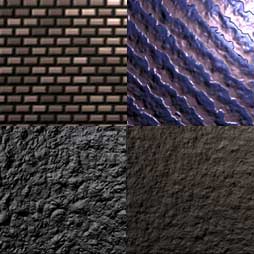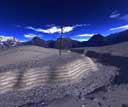
T_Texture
Plugins in the R_Texture set used a fake bumpmapping method resulting in images
with a peculiar look. Sometimes, this could be just the thing you were looking for, but
in general it was simply annoying not to have proper bump maps. So some time ago, I suddenly
felt the urge to work on texture plugins again, aiming to produce proper bumpmaps.
I came up with this new collection of plugins which I call the T_Texture set.
These "T-series" of improved plugins not only produce correct bumpmaps but also have many other features.
Most importantly, output quality has been dramatically increased. I produced a new really uniform sample of random
vectors;(The old one was non-uniform and resulted in a somewhat rectangularish turbulance pattern) did my best to
remove jitter for both intensity and bump-maps; and replaced all calls to random numbers with fixed noise, effectively
removing the flickering in the background of animations. As a result these new plugins are much better suited
for proffesional use than the old ones.
There are three base textures: T_Clouds, T_Marble (which can generate wood textures as well) and T_Bricks;
and two variations: T_Terrain and T_Marble_Terrain. These last two have extra controls for constraining
the altitude and slope that they affect, and can be used to produce good-looking outdoor scenes. (The pictures below
are just test scenes. They don't look good enough, but I didn't have too much time and also did not want to put too much
extra detail. Note that the sky and distant mountains are Terragen.)

Usage tips:
If you are new into using Texture plugins, have a look at Blender's Plugin resource pages. These contain
information on Plugins and links to other plugins for Blender.
At the moment Blender (version 2.23) has a bug in global texture coordinate generation mode. In this mode, it does not send
oversampling information to plugins which causes the plugins to work incorrectly. Therefore, use object mode to simulate
global mode. (You should not use global mode on any other texture layer too, since this activates the bug as well.)
(for simulating global mode: Make sure 3D cursor is at origin; Switch to top view (F7); Add an empty; Return to material buttons, select
object mode and type in the name of the empty.)
The preview window in the texture panel shows a cross-section of the texture at z=0. Note that this may not always give you
an idea of what the texture will look like. For example, if you are using a T_Terrain texture and set minimum altitude to 10,
the preview window will be all black, because z=0 will be below the minimum altitude.
Slope constraints and Oversampling are effective only in OSA mode (When OSA button in Display buttons is selected.)
Slope constraints are not interpolated smoothly between neighbouring faces. That is, all points on a face are processed as if
they all have the same slope. This may result in artifacts,
revealing the polygonal shape of your terrain mesh if the
mesh makes sharp angles and/or the slope constraints have a high sharpness. To remove these artifacts, you can: (a) Use a lower
sharpness value for slope constaints; (b) Smooth your mesh (c) Use a subsurf.
The "Map Max" and "Map Min" buttons work like a simple version of Blender's Colorband. However these controls affect
bumpmapping as well as intensity. Blender's Colorband, brightness and contrast controls only apply to intensity and color
and have no effect on bumpmapping. You can use this fact for creating interesting effects. For example I used the Colorband
for creating snow which is white all across but still "bumpy".

Download:
Windows users can download and use the DLL's directly. Others need to download the sources and
compile them.
Windows DLLs: t_texture.zip
Source files: t_texture_sources.zip
Performance Tips
If you won't use bumpmapping deselect the BumpMap button. This will speed up things.
Similarly, if you won't be using intensity (that is, you are using only bumpmapping), make sure OSA is at 1.
Oversampling does not affect the quality of bumpmapping.
"Two-way filter" button doubles the time for bumpmapping. Use it sparingly.
In general:
time = (OSA + 3 (for bumpmapping) + 3 (for two-way filter))*constant
Created: -November 2001
Last update: -November 2001
Armagan YAVUZ
[email protected]
|



